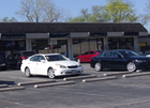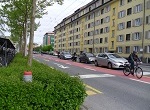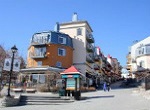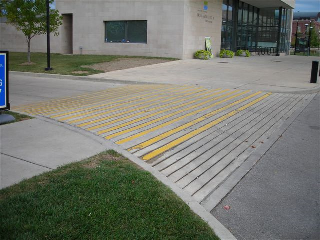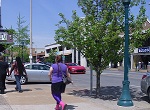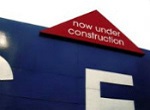How to Approach
Commercial Corridor Redevelopment
Published: August 6, 2024
Are you tired of the gaudy and tall signs, clogged traffic, and frequent empty buildings along a highway or major street in your town? If you have a long business strip oriented toward automobiles and not pedestrians, chances are that about now, you need to consider commercial corridor redevelopment.
A combination of the rapid rise of online retail, changing tastes among young adults who are not so enamored of driving everywhere, and increased emphasis on the health benefits of walking and bicycling has led to these automobile-centered commercial streets losing some of their reason for being.
I have chosen deliberately to talk about redevelopment, not revitalization, because my experience as a planner leads to the conclusion that right now, some major surgery, at least in spots, will be needed to help most cities hold onto and increase the amount of sales and property tax revenue they obtain from their commercial strips.
Note that if you are concerned about a business district, such as an identifiable downtown, your businesses may be healthy enough that our page on commercial district revitalization may be more appropriate. Even so, you may find some of the material on this page helpful; many downtowns and named business districts have some element of a strip, which we call a corridor, within their boundaries.
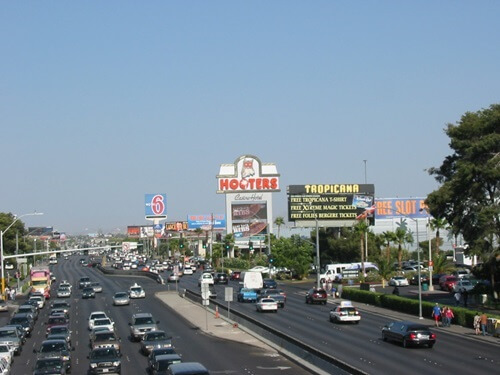
Almost none of you have an example that is as extreme as the Strip in Las Vegas, shown here, but nonetheless, this photo illustrates some characteristics of the commercial corridor. These include large, tall signs; wide streets or highways; a sense that the businesses are connected to one another only by being along the same road; and a forbidding cityscape for pedestrians or bicycles.
Often these commercial corridors in need of redevelopment contain frequent driveways, sometimes more than one per business. Altogether roads, driveways, and paved at-grade parking lots typically constitute at least two-thirds of the available frontage along the street or highway.
On this page, we point out the first things that elected city leaders, planning commissions, and interested businesses and citizens should consider when thinking about how to redevelop these corridors over time. Make no mistake; this is a multi-year, multi-project undertaking.
Why Is Redevelopment So Difficult Along Commercial Strips?
When we consider what has led to poor business performance recently along long and narrow business corridors, we see these problems:
- Too much retail space
- Competing, more successful business districts or commercial corridors
- Front-of-store parking, making the area seem more deserted and less interesting
- Excessive parking requirements in the zoning ordinance, now and in the past
- A mistaken policy of zoning in long strips rather than in compact districts, whether or not this policy now has been corrected
- An aggressive and effective outdoor signage industry that often encourages taller and larger signs and billboards
- State highway departments that are saturated with the mentality of moving traffic faster and faster, at the expense of pedestrians and bicyclists, sometimes with little regard for how "through" traffic impacts the locals
- Lack of landscaping, whether because municipal zoning does not require it, developers and property owners see it only as an expense, or roadway widening has left little room for it
- A history of small land parcels, which makes it difficult for developers to assemble the land that is needed for a unified development plan
- Frequent driveways inefficiently placed, whether because the zoning and other land use regulations did not prohibit them, or because transportation officials often thought in the past that the more driveways, the better.
The Appearance and Image Argument for Tackling Commercial Strips
Often any citizen complaints about commercial corridors zero in on either the sometimes chaotic and unpleasant visual aspects of the strip or else the empty parking lots where businesses have left (but sometimes not removed their signs).
Some residents may be able to conclude correctly that these characteristics negatively impact the impression that other neighborhoods and other nearby towns have of your city. A few of them will realize that this negative image also keeps your community from attracting the kind of investment that creates jobs, provides a pleasant environment for current residents, and assures the financial stability of the city.
If these ideas are expressed in a public forum, other residents will object that the appearance of the commercial corridor doesn't bother them and that they have never thought about it. That is quite possibly true, but in my professional life, when I have presented residents with a manipulated image of the same strip cleaned up, they would choose that alternative to present conditions.
The visual cleanup though isn't an instant fix. It takes time to modify your sign ordinance and have the new, smaller signs gradually populate the area when someone needs a new sign. It takes time for many landscaping solutions, especially street trees, to grow to maturity. Unless you have a very gutsy governing body, you are not going to be able to persuade or coerce businesses into eliminating unnecessary driveways and parking overnight. You can't expect an empty commercial building, especially a large one, to be reoccupied in a month or two. You are probably not going to suddenly find the funding to undertake a major capital project, such as narrowing the roadway to create space for pedestrians, bicycles, scooters, and landscaping, benches, and outdoor dining.
While I support every kind of cleanup on these pages, cleanup alone is insufficient to convert most wide-road commercial corridors into a pleasant environment that attracts businesses and therefore supports residents' shopping needs and municipal finances.
Action Steps in Commercial Corridor Redevelopment
The first thing I have to say about what to do if you recognize these problems will not be very popular. I have decided that my experience leads me to tell you that aesthetic improvements alone will not be enough to save a business corridor that is at least several blocks long and probably only one parcel deep along the roadway. Yes, it would be great if you can revise your sign regulations, which may be found in a standalone ordinance or more likely in the zoning ordinance. Over time, you can successfully transition businesses into having shorter and smaller signs. The first ones to need to comply will complain bitterly, but in a while, this will improve appearance.
You could require landscaping, or if your city owns a sufficiently wide right-of-way, install it yourself. If you control the roadway, you could consider a "road diet," in which one or more lanes are taken away from vehicles and added to the landscape buffer, or perhaps converted into bicycle-only and/or bus-only lanes.
All of these steps would be helpful, and where there is the political will, you can start there.
However, in auto-dependent corridors, usually these improvements will not be enough. You cannot ignore market economics. And the market is telling us that most cities have way too much commercial space and too few businesses wanting to occupy it.
The problem becomes: if we can't support commercial space and we don't want vacant buildings and land, what should we do?
The answer is you should begin to consider whether you can implement one of the two most common recommendations. Both of them will require an interested developer, community development corporation, or local government acquiring some property in order to resolve problems before finding one or more developers.
First, you can investigate mixed-use development, if there is a realistic possibility of acquiring control of a suitable amount of land. This term simply means that two or more land uses are contained in the same building or same development. The mix of uses may be either vertical, such as a retail business on the ground floor and offices or apartments on higher floors, or horizontal, such as either parts of the same building being used for maybe commercial and residential or the construction of separate but related buildings with different land uses. If you doubt the advantages of mixed-use development, read our page on the subject.
If you opt for a horizontal mixed-use project, you may need to assemble a larger tract than would be necessary for the same square footage of a vertical mixed-use development.
Second, another viable option is to obtain control of one or more parcels of land to develop multi-family housing. Besides providing housing options that are much needed in some cities, the addition of a ready-made customer base will support existing businesses. If the scale is large enough, a development could even lead to a satisfactory increase in occupancy rate of commercial space and a gradual upgrade in the quality of businesses available to residents and other shoppers.
Many residents and even some business owners turn up their noses at the idea of multi-family housing. One neighborhood leader even brightened when I made this suggestion and said that they could try to attract a hotel. I said no, that isn't the same, quickly pouring cold water on her enthusiasm. A hotel is not the same because guests are unlikely to stray far from the hotel at all, especially if the roadway is wide and unfriendly to pedestrians. If guests drive to nearby fast food restaurants, that may be helpful to them but it will do little to restore the look, functioning, and feel of the business corridor. The hotel idea is not a very good solution.
Absent a very aggressive effort by a municipal government, including abundant use of eminent domain to acquire property, it is unlikely that an entire commercial corridor can be acquired for redevelopment. Your best tactic then may be to designate a few areas along the corridor where you believe a developer can assemble some land fairly easily, and then develop these either in a mixed-use format or more likely in a multi-family building. Instead of pre-selecting the spots, it is probably even better to work with developers to identify the art of the possible.
If we fast forward a few years to an idealistic future where you have developed several nodes of mixed-use or multi-family housing, it now becomes feasible to think about connecting these or other lively land uses with a shuttle van or bus, which would improve tenant satisfaction in any rental housing you have established and also make it more desirable for some shoppers to move along the corridor.
But at every step of the way, you have to be vigilant about whether you have enough market demand for what you want to do. In a capitalist country, the market is king in almost every instance, even if there is a substantial amount of governmental support in project financing and logistics.
So do not assume that just because you want a certain kind of retail, you can have it. Do not even assume that if you take my advice and decide you want to put up an apartment building to increase demand for goods and services along the corridor that the market to support that housing is present.
Do your market research, regardless of what you plan!
Listen to experienced and successful developers and what they think of a proposed or theoretical project--not their own, of course. (My experience is that developers tend to be myopic about projects they have fallen in love with.) Beyond that, if you have no money for a consultant, which pertains to most small cities and towns, you can talk to whatever commercial realtors are active in your city or a nearby one or look at publicly available sources such as LoopNet or large commercial real estate firm CBRE on the internet. You can ask neighboring towns about their recent experience. But don't listen to your cousin-in-law who sells single-family residential real estate.
Choosing Which Corridor Merits the Most Attention
Another hard truth is that if you have several of these commercial corridors in your community, each of which is looking pretty tacky and yet not functioning well in spite of a high vacancy rate, you can't make a substantial difference in all of them at the same time unless you are in a true boom town situation. I've worked in two extremely fast-growing U.S. cities, and I wouldn't try that even there.
You will need to pick and choose where to put your effort and resources. If the private sector picks up two or more corridors at the same time, consider yourself lucky, but don't count on it as a strategy. In fact, if there is developer interest in more than one area, the city needs to deliberate carefully on how much redevelopment it can afford to support, both in terms of staff time and possible incentive or public improvement money needed. Then this decision needs to conveyed to the developers in question at the earliest possible moment to prevent misunderstandings.
If you are facing this difficult choice, you should consider whether one has a better locational advantage, what the market says about your choices, whether there are supportive organizations or large businesses or nonprofits in one area, and last but not least, whether the personalities influential in the commercial corridor get along with one another and can get behind a common vision. Often the most successful operators in a commercial corridor are highly resistant to change, so pay attention to the interpersonal dynamics, if indeed the people even know one another at all.
Lastly, consider existing developer interest in the areas. Do this informally rather than by issuing a formal call for proposals. For example, you may be able to make a presentation to an appropriate group of local builders. You might be able to go directly to any developers who have been active in your community in the last decade or so. You also could solicit letters of interest, making it clear that you want literally a letter of no more than one page listing any parts of your city where a developer is curious about opportunities. Then enlist your staff, planning commission members, any consultants you use regularly, or residents to discuss this informal research and think about where developer interest appears to be strongest.
Summary Thoughts about Commercial Corridor Redevelopment
Here are the main takeaways I leave you with:
- Acknowledge and take advantage of resident concern about the appearance of a business strip, difficult turning movements, heavy traffic, and lack of pedestrian safety.
- Begin a program of addressing the aesthetic and functional challenges that can be resolved over time through zoning ordinance improvements.
- Become realistic about the market for commercial redevelopment, as compared to what is probably an oversupply of certain types of spaces, especially retail. If you can afford it, hire a firm to do a market study, but if not, engage in a little informal market investigation of your own.
- Realize that cities cannot always hope to achieve meaningful redevelopment of every commercial strip simultaneously, and make good choices about where city resources will be concentrated.
If you have been following this article closely, you may be ready for more detailed direction. If your planning commission and city staff are working at near capacity now, or if you feel that collectively you lack the expertise needed to take the next steps, you will need a consultant. To find one, begin to ask other cities in your region for any recommendations they may have, and ponder your own budget for consulting services. You will find some relevant information about consultant management on our page about city planning consultants. Although many planning consultants cannot manage all aspects of something as complex as corridor redevelopment, they typically will know other consultants who specialize in market studies, analysis of real estate development proposals that are known as pro formas, and the intricacies of economic development subsidy programs.
Resources for You
Literally dozens of pages on this website may address some aspect of your situation. Below I have chosen the ones most likely to be useful, but do be sure to use the Search button on almost every page and perhaps to browse the Sitemap as well. Our list of resource pages on this website for business districts (as opposed to business corridors) may help you navigate as well.
- Community Development >
- Community Challenges, Common Topics, and Concepts >
- Economic Development > Commercial Corridor Redevelopment
Join GOOD COMMUNITY PLUS, which provides you monthly with short features or tips about timely topics for neighborhoods, towns and cities, community organizations, and rural or small town environments. Unsubscribe any time. Give it a try.
